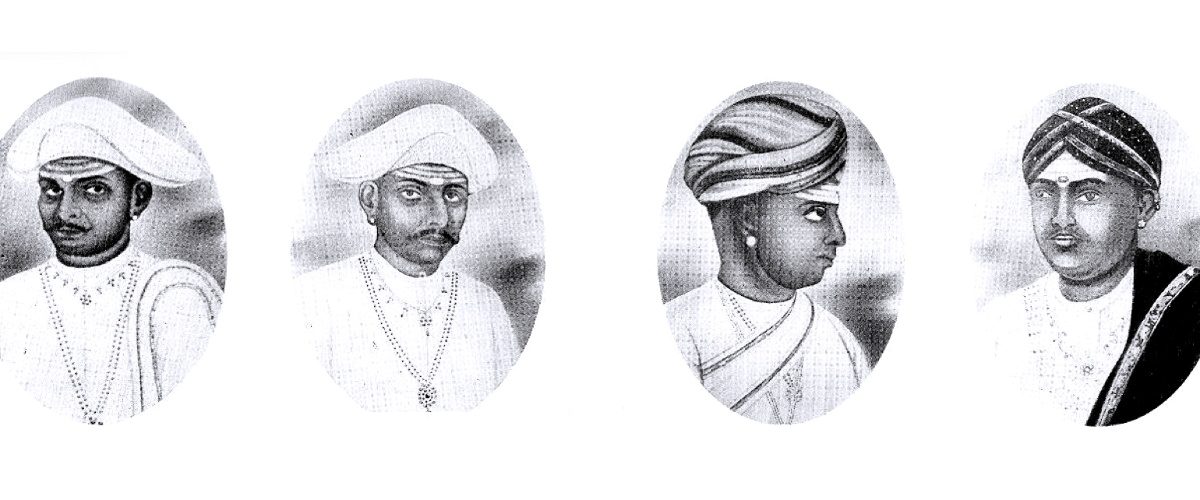

The Thanjavur or Tanjore Quartet of the early 19th century consisted of four brothers who made an enormous contribution to South Indian classical dance. In so doing, they also left a permanent influence on Carnatic music by composing a number of varnams and kritis (three-line songs).
The Pillai brothers, Chinnaya (1802-1856), Ponnaya (1804-1864), Sivanandam (1808-1863) and Vadivelu (1810-1845) served as court musicians at Thanjavur during the reign of the Maratha King Serfoji II and later at Travancore, a princely state under the Maharajah Swathi Tirunal (himself a gifted composer and leading patron of the arts).
They are best remembered for the revival and codification of the ancient temple dance style bharatanatyam, turning it into a fully-fledged performance art with its own, specifically composed music as well as adding new sequences which enhanced various aspects of the tradition.
Initially based in Thanjavur, one of India’s most ancient cities, the brothers, encouraged by royal patronage, made an in-depth study of classical music, being tutored by some distinguished musical figures of the time including Mutthuswami Dikshitar (the youngest member of the famous Holy Trinity of South Indian composers). The Quartet paid tribute to their teacher in the form of a set of nine songs known as the navaratna mala (‘garland of nine jewels').
The youngest brother, Vadivelu, is generally considered the most exceptionally gifted of the four and was a favourite pupil of Dikshitar. It is said that he was able to reproduce a song after just one hearing. At Travancore, Vadivelu studied the violin with a European missionary and began looking into modifications to the instrument so it could be adapted for use in South Indian classical music.
Although other South Indian musicians of the time also studied the violin and attempted to introduce it to Carnatic music, it was chiefly Vadivelu’s efforts that finally won over the purists who had, until then, viewed the instrument as a purely European one, therefore assumed to be unsuited to India's sacred music.
The Tanjore Quartet, and in particular, Vadivelu, is also credited with the revival and introduction of a new repertoire for the classical dance form known as mohiniattam (‘dance of the enchantress’) which was specifically designed for women dancers. Up until this time, the predominant dance form in Kerala was kathakali, a highly stylised narrative form which was entirely masculine in character and could be performed only by men.
Watch the dance in action | Young bharatanatyam exponent Mythili Prakash superbly demonstrates the style's intricate footwork. Recorded at Darbar Festival 2017, at Sadler's Wells in London.
Jameela Siddiqi is an author, linguist, and BBC cultural commentator, specialising in postcolonial fiction and the devotional music of South Asia.
Darbar believes in the power of Indian classical music to stir, thrill, and inspire. Explore our YouTube channel, or subscribe to the Darbar Concert Hall to watch extended festival performances, talk and documentaries in pristine HD and UHD quality.
Swami Haridas, a mystic-musician and renowned guru of the early 16th century, is thought to have had an innate...
Read More 
Three 18th century composers - Shyama Shastri, Tyagaraja and Muthuswami Dikshitar - form what is known as Carnatic...
Read More 
To touch, or tug at one or both ears, is a visible sign of repentance in South Asian cultures. But one often notices...
Read More 
The beginner's guide to Indian classical music. Whether you’re completely new to raga music or just need a refresher, we’ve put together this brief overview of all things raga music to help you feel at ease when visiting one of our concerts or watch our videos on our YouTube or our Darbar Concert Hall.
Keep up to date with the latest news, events, music and musings across our social channels
For hundreds more clips and shorts, vist our YT page here 